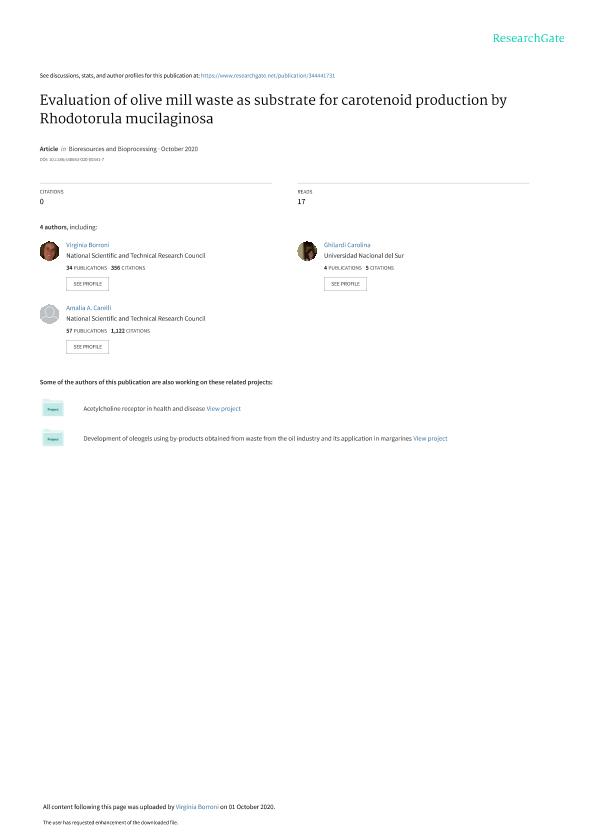Mostrar el registro sencillo del ítem
dc.contributor.author
Ghilardi, Carolina

dc.contributor.author
Sanmartin Negrete, Paola Tatiana

dc.contributor.author
Carelli Albarracin, Amalia Antonia

dc.contributor.author
Borroni, Maria Virginia

dc.date.available
2021-04-08T15:55:05Z
dc.date.issued
2020-12
dc.identifier.citation
Ghilardi, Carolina; Sanmartin Negrete, Paola Tatiana; Carelli Albarracin, Amalia Antonia; Borroni, Maria Virginia; Evaluation of olive mill waste as substrate for carotenoid production by Rhodotorula mucilaginosa; Springer; Bioresources and Bioprocessing; 7; 1; 12-2020; 1-11
dc.identifier.issn
2197-4365
dc.identifier.uri
http://hdl.handle.net/11336/129632
dc.description.abstract
The “alperujo” is a waste from the olive oil industry with great potential for valorization. It has a high organic load, with the presence of valuable compounds such as biophenols and sugars. The use of this waste can be thought of as a biorefinery from which different compounds of high added value can be obtained, whether they are present in the “alperujo” such as biophenols or can be generated from the “alperujo”. Therefore, the production of carotenoids by Rhodotorula mucilaginosa was evaluated using the liquid fraction of ‘alperujo’ (Alperujo Water, AW) or an aqueous extract (AE) of “alperujo” at different concentrations (5, 10, 20 and 30% w/V) as substrates. The AEs had an acidic pH, a total sugar concentration ranging from 1.6 to 7.6 g/L, a polyphenols content from 0.4 to 2.9 g/L and a significant amount of proteins (0.5–3 g/L). AW is similar in composition as 30% AE, but with a higher amount of total sugars. Rh. mucilaginosa was able to grow at the different mediums with consumption of glucose and fructose, a reduction in protein content and alkalinization of the medium. Maximum total carotenoid production (7.3 ± 0.6 mg/L) was achieved at AW, while the specific production was higher when the yeast grew at AW or at 30% AE (0.78 ± 0.06 and 0.73 ± 0.10 mg/g of biomass, respectively). Torulene and torularhodin were the main carotenoids produced. Polyphenol content did not change; thus, it is still possible to recover these compounds after producing carotenoids. These results demonstrate the feasibility of using alperujo-based mediums as cheap substrates to produce torularhodin and torulene and to include this bioprocess as a step in an integral approach for alperujo valorization.
dc.format
application/pdf
dc.language.iso
eng
dc.publisher
Springer

dc.rights
info:eu-repo/semantics/openAccess
dc.rights.uri
https://creativecommons.org/licenses/by-nc-sa/2.5/ar/
dc.subject
ALPERUJO
dc.subject
CAROTENOIDS
dc.subject
MICROBIAL GROWTH
dc.subject
TORULARHODIN
dc.subject
TORULENE
dc.subject
WASTE VALORIZATION
dc.subject.classification
Bioproductos, Biomateriales, Bioplásticos, Biocombustibles, Bioderivados, etc.

dc.subject.classification
Biotecnología Industrial

dc.subject.classification
INGENIERÍAS Y TECNOLOGÍAS

dc.title
Evaluation of olive mill waste as substrate for carotenoid production by Rhodotorula mucilaginosa
dc.type
info:eu-repo/semantics/article
dc.type
info:ar-repo/semantics/artículo
dc.type
info:eu-repo/semantics/publishedVersion
dc.date.updated
2021-02-18T15:18:46Z
dc.identifier.eissn
2197-4365
dc.journal.volume
7
dc.journal.number
1
dc.journal.pagination
1-11
dc.journal.pais
Estados Unidos

dc.journal.ciudad
Nueva York
dc.description.fil
Fil: Ghilardi, Carolina. Consejo Nacional de Investigaciones Científicas y Técnicas. Centro Científico Tecnológico Conicet - Bahía Blanca. Planta Piloto de Ingeniería Química. Universidad Nacional del Sur. Planta Piloto de Ingeniería Química; Argentina
dc.description.fil
Fil: Sanmartin Negrete, Paola Tatiana. Consejo Nacional de Investigaciones Científicas y Técnicas. Oficina de Coordinación Administrativa Houssay. Instituto de Tecnología en Polímeros y Nanotecnología. Universidad de Buenos Aires. Facultad de Ingeniería. Instituto de Tecnología en Polímeros y Nanotecnología; Argentina
dc.description.fil
Fil: Carelli Albarracin, Amalia Antonia. Consejo Nacional de Investigaciones Científicas y Técnicas. Centro Científico Tecnológico Conicet - Bahía Blanca. Planta Piloto de Ingeniería Química. Universidad Nacional del Sur. Planta Piloto de Ingeniería Química; Argentina
dc.description.fil
Fil: Borroni, Maria Virginia. Consejo Nacional de Investigaciones Científicas y Técnicas. Centro Científico Tecnológico Conicet - Bahía Blanca. Planta Piloto de Ingeniería Química. Universidad Nacional del Sur. Planta Piloto de Ingeniería Química; Argentina. Consejo Nacional de Investigaciones Científicas y Técnicas. Oficina de Coordinación Administrativa Houssay. Instituto de Tecnología en Polímeros y Nanotecnología. Universidad de Buenos Aires. Facultad de Ingeniería. Instituto de Tecnología en Polímeros y Nanotecnología; Argentina
dc.journal.title
Bioresources and Bioprocessing
dc.relation.alternativeid
info:eu-repo/semantics/altIdentifier/url/https://bioresourcesbioprocessing.springeropen.com/articles/10.1186/s40643-020-00341-7
dc.relation.alternativeid
info:eu-repo/semantics/altIdentifier/doi/http://dx.doi.org/10.1186/s40643-020-00341-7
Archivos asociados
